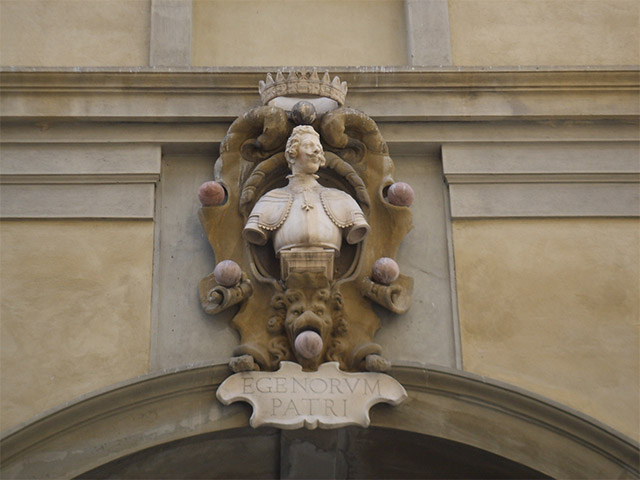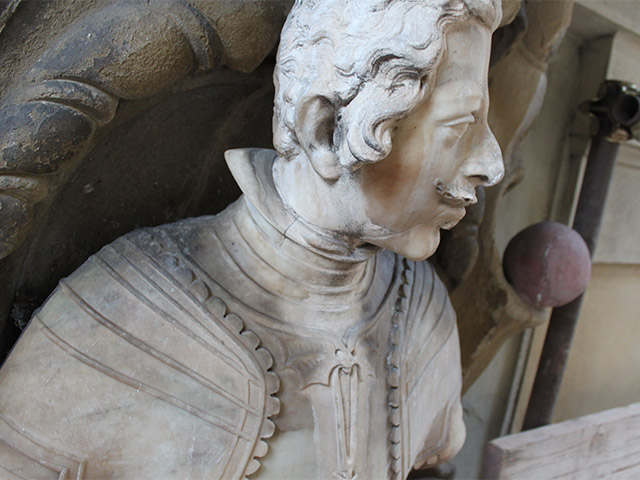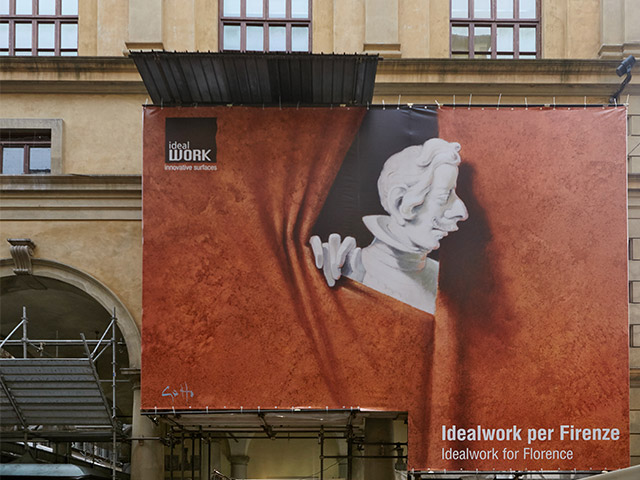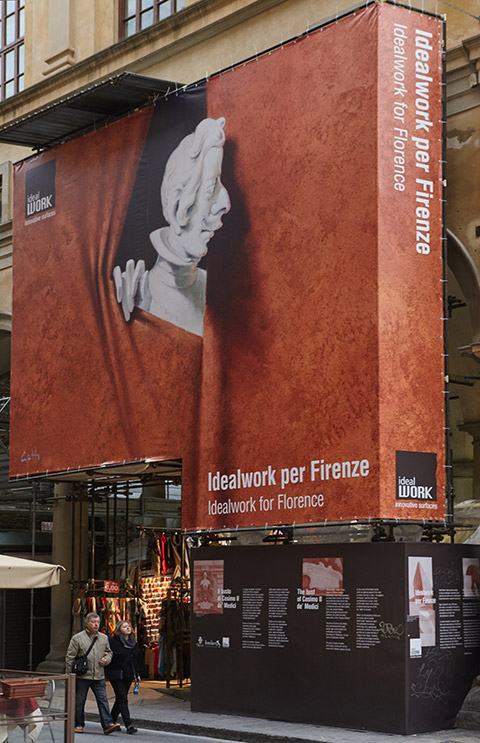Ideal Work, restoration sponsor, chose Gatto to illustrate the sheet covering the works
Ideal Work is sponsoring the restoration of the coat-of-arms of Cosimo II de’ Medici. The covering sheet is illustrated by the artist Alessandro Gatto

Ideal Work has begun to restore the coat-of-arms of Cosimo II de’ Medici above the main arch of the Loggia del Grano (Grain Market) in Florence.
The restoration of the coat-of-arms, which had fallen into a state of disrepair, is being financed by Ideal Work in a project proposed by Fondaco, a company that specialises in cultural sponsorship.
Ideal Work decided to offer the surface of the covering sheet of the restoration works to Alessandro Gatto, the best humourist and illustrator in the world. The work portrays an unfamiliar Cosimo II, who observes the city, looking out from under the sheet. Gatto has presented Florence with an original piece of contemporary art, based on an ironic observation of daily life.

“We are delighted to undertake this project in the city of Florence, one of the cultural capitals of Italy,” said Luca Seminati and Maurizio Pontello, founding partners of Ideal Work, “and we especially want to thank the Municipality of Florence, the Superintendency and Fondaco for making its creation possible. An operation in the drawing room of the city with one of its symbols, of which we are particularly proud.”
In choosing to restore the artistic splendour of 17th century Florence and make space for the contemporary art of Alessandro Gatto, Ideal Work once again displays its aptitude for experimentation and its special affinity with the world of art and architecture.

The Coat-Of-Arms of The Medici, a symbol of florentine and italian art
The so-called “Loggia del Grano”, begun in 1619 to a design by the architect Giulio Parigi, who was commissioned by Grand Duke Cosimo II de’ Medici, is located between Via de’ Neri and Via Castellani and served as a grain and cereals market. The bust of Cosimo II de’ Medici, who commissioned the work, towers high above on the middle arch overhanging Via de’ Neri and is the work of Chiarissimo Fancelli (according to F. Baldinucci). The bust is made of marble and Cosimo, armed and with the cross of Saint Stephen, is framed by the coat-of-arms of the Medici dynasty (six balls placed in the wall, of which the top one is in blue, courtesy of the French, and the others in red) topped with a crown while, in the lower part, a lion’s head holds one of the six balls between its jaws. Below, on the arch’s keystone, a cartouche, also in marble, reads “egenorum patri”. The celebration of the sovereign is clear and, depicted between the symbols of the family and the city, he is described as the “father of the needy”, undoubtedly a reference to the loggia’s function as a storage warehouse and in the supply of basic goods to sustain the people

Alessandro Gatto, the king of humourous illustration
Alessandro Gatto was born in 1957 in Castelfranco Veneto, where he lives and works as a graphic artist and painter. He has carried out commissions for companies and public organisations in Italy and abroad (the United States, Canada, Argentina, Mexico, Algeria, England, Greece, Switzerland and Germany). Since 1985, he has focused on humorous illustrations and graphics.
The writer, Marco Balestracci, also from Castelfranco Veneto and a great friend of Alessandro Gatto, describes the artist’s style and interprets the Florentine work in this way:
“There is no particular way to become one of the most significant contemporary humorous artists. In the case of Alessandro Gatto, it is his way of thinking, above all, that makes him that. When he received the commission to paint the sheet covering the restoration works of the bust of Cosimo II De’ Medici, Gatto did not dwell on the image of the warrior at arms. Not at all. Instead, he thought that, after more than 300 years spent observing Loggia del Grano from on high over Via de’ Neri, being obliged to remain covered for a while due to the restoration, Cosimo II would enjoy having a look outside the sheet every now and again to make sure everything down below is proceedings as it should. Moreover, the artist felt that modern-day Florentines, having seen him without his hands for so long, would enjoy seeing the features of even one of the Grand Duke’s hands. The sheet is the outcome of these musings and it is this peculiar way of observing the world that sums up the essence of the art of Alessandro Gatto. Fantasy, insight, the speed of decision-making and execution come together perfectly in the fifty-nine-year-old. All of which, in the opinion of Mario Monicell, are the qualities of genius.”